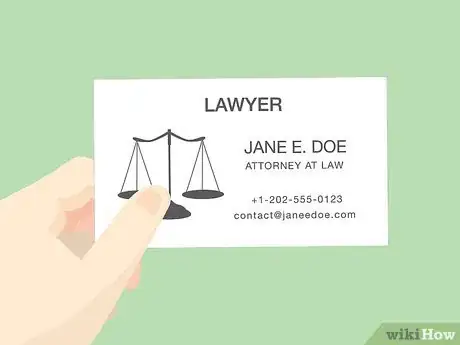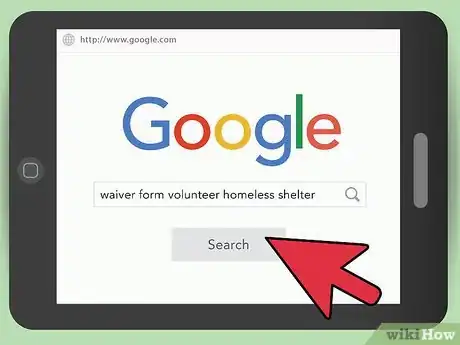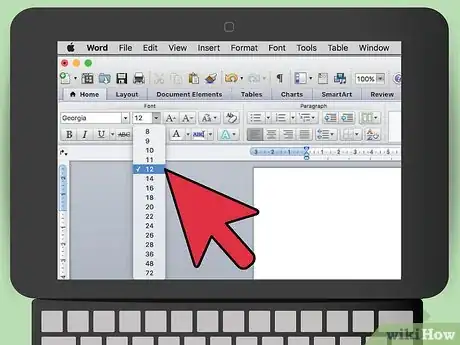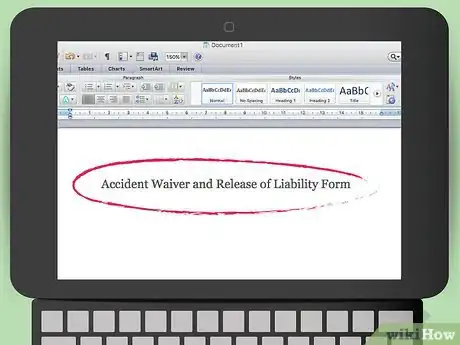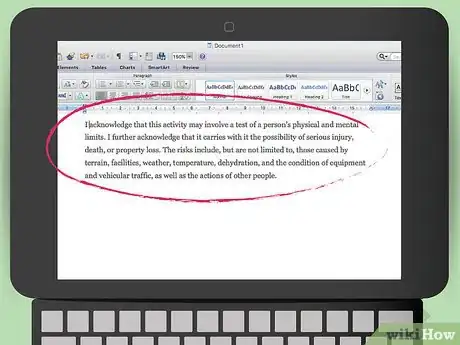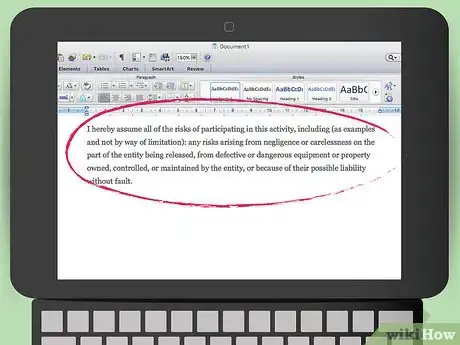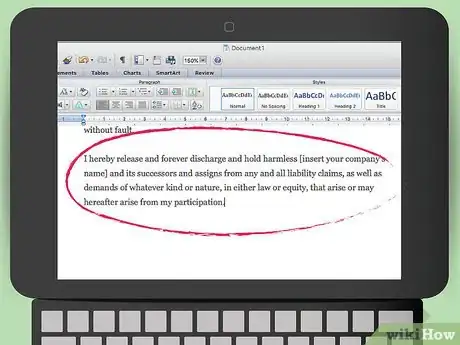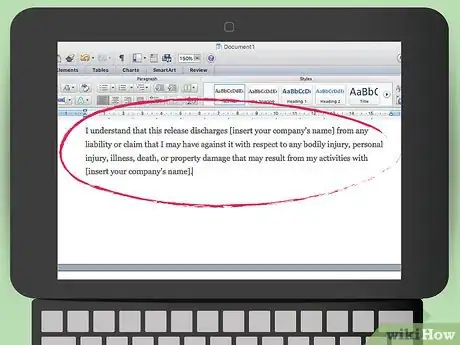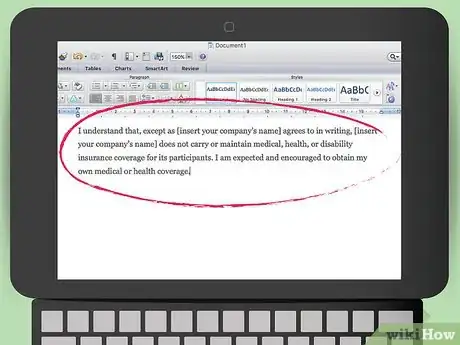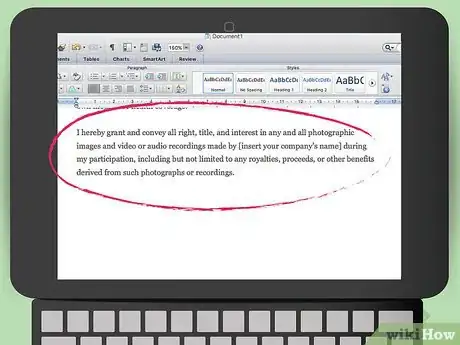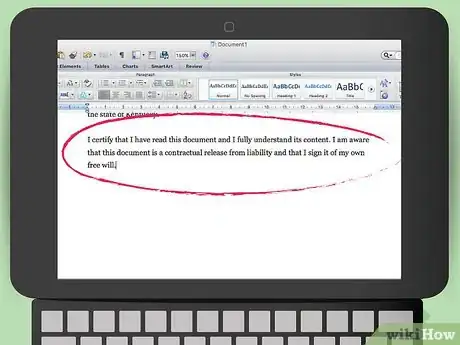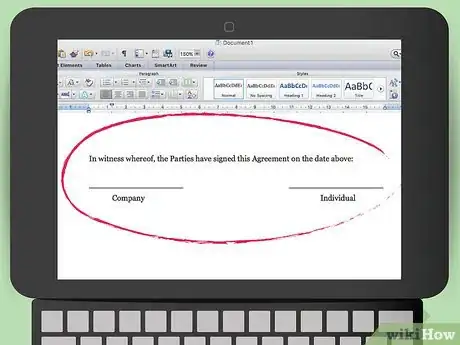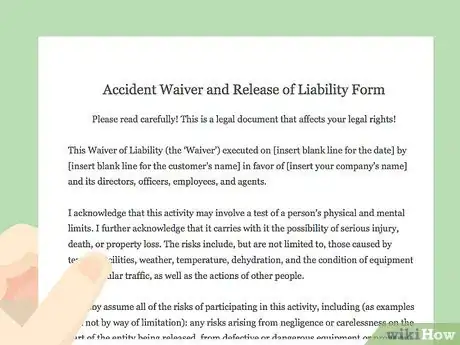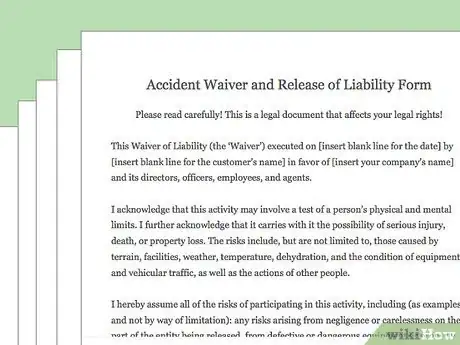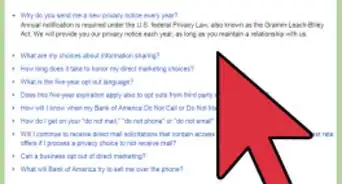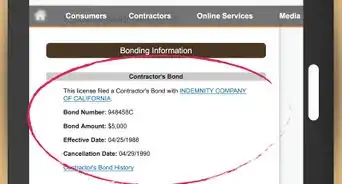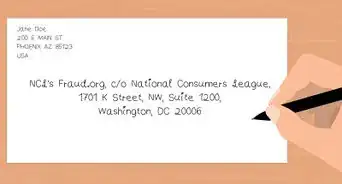This article was co-authored by Clinton M. Sandvick, JD, PhD. Clinton M. Sandvick worked as a civil litigator in California for over 7 years. He received his JD from the University of Wisconsin-Madison in 1998 and his PhD in American History from the University of Oregon in 2013.
This article has been viewed 47,114 times.
A waiver of liability is an agreement not to sue someone because of an event or occurrence. For example, you can sign a waiver of liability before sky diving. By signing the waiver, you assume the risk of injury and agree not to sue the company that offers the sky diving.[1] To draft an effective waiver of liability for your business, you should find examples of waivers used by other businesses in your industry. Then you should make sure that your waiver contains certain essential provisions.
Steps
Beginning to Draft the Waiver
-
1Consult with a lawyer if you have questions. Drafting a waiver should be fairly straightforward. Nevertheless, you may have questions along the way. Make sure to consult with a qualified attorney so that the waiver you create is legally effective.
- If you don’t have a lawyer, then you can get a referral by calling your local or state bar association.[2]
- You can also show the lawyer a finished draft and ask for input.
-
2Find examples of waivers in your industry. Each industry has slightly different needs when it comes to waivers. For example, the waiver of liability for a sky diving company might be a little different than a waiver for volunteers who work in a homeless shelter. You can tell what is considered standard by finding waivers used by competitors in your industry.
- You should look on the Internet to see if there are any samples. You could search “waiver form sky diving” or “waiver form volunteer homeless shelter.”
Advertisement -
3Format the document. You can draft your own waiver of liability by opening a blank word processing document. Set the font to a readable size and style. Times New Roman 12 point is typical, but you should also mix up font sizes for important provisions.
- For example, many waivers use bold to highlight important information. They also might put important information in all caps or in a larger font than the rest of the document.
-
4
-
5Warn the signer to read the waiver carefully. Two lines below the title, you can insert a warning that the signer should read the waiver carefully. You can put this warning in bold and even increase the font size, to 14 point.
- A warning might state: “Please read carefully! This is a legal document that affects your legal rights!”[5]
-
6Include the date the waiver is executed. Set up your waiver as a template, so that you can fill in the person’s name and the date. In this way, you can make copies of the template and write in the relevant information. Sample language could read:
- “This Waiver of Liability (the ‘Waiver’) executed on [insert blank line for the date] by [insert blank line for the customer’s name] in favor of [insert your company’s name] and its directors, officers, employees, and agents.”[6]
Including Provisions about Releasing You from Liability
-
1Explain the risks involved with your activity. By including this information, you force the signer to understand why the activity is dangerous. In this way, he or she can make an informed choice about whether or not to participate in your activity. Write the waiver in the first person, so that it reflects the person signing it.
- Depending on the activity, your description might read: “I acknowledge that this activity may involve a test of a person’s physical and mental limits. I further acknowledge that it carries with it the possibility of serious injury, death, or property loss. The risks include, but are not limited to, those caused by terrain, facilities, weather, temperature, dehydration, and the condition of equipment and vehicular traffic, as well as the actions of other people.”[7]
-
2Include an “assumption of risk” clause in the waiver. Legally, people are able to participate in a dangerous activity and assume the risk that they will be injured. This means that they cannot turn around and try to blame someone else when they get hurt—they knew of the risks and assumed them anyway. Insert a clause where the signer explicitly assumes the risk.
- For example, you could write: “I hereby assume all of the risks of participating in this activity, including (as examples and not by way of limitation): any risks arising from negligence or carelessness on the part of the entity being released, from defective or dangerous equipment or property owned, controlled, or maintained by the entity, or because of their possible liability without fault.”[8]
-
3Include a “hold harmless” provision in the waiver. You also need to use these words in your waiver for it to be effective. By agreeing to hold you harmless, the signer agrees not to sue you.
- Sample language could read: “I hereby release and forever discharge and hold harmless [insert your company’s name] and its successors and assigns from any and all liability claims, as well as demands of whatever kind or nature, in either law or equity, that arise or may hereafter arise from my participation.”[9]
-
4Specify which injuries the release applies to. You do not have to include this information, but it might be helpful. In a paragraph, list the kinds of injuries someone would likely sue your company for. If you don’t know, then speak to other businesses in your industry and ask what kinds of injuries customers have sued them for.
- For example: “I understand that this release discharges [insert your company’s name] from any liability or claim that I may have against it with respect to any bodily injury, personal injury, illness, death, or property damage that may result from my activities with [insert your company’s name].”
-
5State that you don’t provide insurance for participants. Some participants might wrongly think that you have insurance which covers your customer’s injuries. You should include a provision stating that you don’t provide insurance.
- “I understand that, except as [insert your company’s name] agrees to in writing, [insert your company’s name] does not carry or maintain medical, health, or disability insurance coverage for its participants. I am expected and encouraged to obtain my own medical or health coverage.”[10]
-
6Include a provision on using the signer’s photographic likeness. You might photograph or videotape your activity for marketing purposes. For example, you might make a video to post online as part of an effort to promote your business. Because you can’t use someone’s image without their permission, you should include a release for using someone’s likeness.
- You could type, “I hereby grant and convey all right, title, and interest in any and all photographic images and video or audio recordings made by [insert your company’s name] during my participation, including but not limited to any royalties, proceeds, or other benefits derived from such photographs or recordings.”[11]
Including Boilerplate in the Waiver
-
1Explain how the waiver should be interpreted. In reality, a court will interpret the waiver in the way the law requires. However, it doesn’t hurt to include a clause stating that the waiver will be interpreted broadly. You could include something like the following:
- “This waiver shall be construed broadly to provide a release and waiver to the maximum extent permissible under applicable law.”[12]
-
2Include a “severability clause” in the waiver. Generally, if a judge finds that one part of a contract is invalid, then the judge will invalidate the entire contract. Accordingly, you should include a severability clause. This clause states that if one portion of the agreement is invalid, the rest will remain in force.
- This is fairly standard language to include: “I agree that in the event that any clause or provision of this waiver and release shall be held invalid by any court of competent jurisdiction, the invalidity of such a clause or provision shall not otherwise affect the remaining provisions of this waiver and release, which shall continue to be enforceable.”[13]
-
3Add a choice of law provision to the waiver. If the participant ends up suing you, then a judge will have to decide if the signed waiver prevents the lawsuit. This requires the judge to interpret the waiver. You can pick which state’s law will control the interpretation of the contract. Generally, businesses choose the law of the state where they are located.
- A sample choice of law provision could state: “I agree that any and all claims or litigation arising from my participation in this activity will be governed by the laws of the state of Kentucky.”
-
4Confirm that the signer has read the waiver. It can’t hurt to include a few sentences above the signature line to the effect that the person signing the waiver has read it and understood its contents. Including this sentence will prevent the signer from later claiming that he or she signed it without really understanding its substance.
- You could type the following above the signature line: “I certify that I have read this document and I fully understand its content. I am aware that this document is a contractual release from liability and that I sign it of my own free will.”[14]
Executing the Waiver
-
1Add signature lines to the waiver. Move down a few lines and insert a line for the participant to sign. Also include a line for the date. Remember that each participant should sign their own waiver. If a couple comes to your business, then each person should sign a waiver.
- You also might want to have a witness sign as well. This person could testify later in case of a lawsuit that the participant signed the waiver out of his or her own free will.
- If you want a witness to sign, then include a line for the witness’s signature.
-
2Have the person read the waiver. You want to make sure that the signer actually reads the waiver before signing it. Make sure that the waiver is read and signed before the person takes part in the risky activity.[15]
- Hand the waiver over and say, “Take a few minutes to read this so that you understand it.” Make sure the person doesn’t just sign it without reading.
- Don’t rush them to sign either. Instead, sit calmly and wait for them to finish.
- Answer any questions that they may have.
-
3Distribute copies of the signed waiver. After the person signs, make a photocopy. You should hold onto the signed original and give the participant a copy of the waiver.
- Store your waivers in the same place for easy access.
References
- ↑ http://www.lawhelp.org/files/7C92C43F-9283-A7E0-5931-E57134E903FB/attachments/B2D45E53-D266-7BAB-6ECA-914B78E09076/alert-waivers-of-liability-for-volunteers-jan-2010.pdf
- ↑ http://www.nycbar.org/get-legal-help/
- ↑ http://www.esa.org/mexico/AccidentWaiver_Form.pdf
- ↑ http://www.lawhelp.org/files/7C92C43F-9283-A7E0-5931-E57134E903FB/attachments/B2D45E53-D266-7BAB-6ECA-914B78E09076/alert-waivers-of-liability-for-volunteers-jan-2010.pdf
- ↑ http://www.lawhelp.org/files/7C92C43F-9283-A7E0-5931-E57134E903FB/attachments/B2D45E53-D266-7BAB-6ECA-914B78E09076/alert-waivers-of-liability-for-volunteers-jan-2010.pdf
- ↑ http://www.lawhelp.org/files/7C92C43F-9283-A7E0-5931-E57134E903FB/attachments/B2D45E53-D266-7BAB-6ECA-914B78E09076/alert-waivers-of-liability-for-volunteers-jan-2010.pdf
- ↑ http://www.esa.org/mexico/AccidentWaiver_Form.pdf
- ↑ http://www.esa.org/mexico/AccidentWaiver_Form.pdf
- ↑ http://www.lawhelp.org/files/7C92C43F-9283-A7E0-5931-E57134E903FB/attachments/B2D45E53-D266-7BAB-6ECA-914B78E09076/alert-waivers-of-liability-for-volunteers-jan-2010.pdf
- ↑ http://www.lawhelp.org/files/7C92C43F-9283-A7E0-5931-E57134E903FB/attachments/B2D45E53-D266-7BAB-6ECA-914B78E09076/alert-waivers-of-liability-for-volunteers-jan-2010.pdf
- ↑ http://www.lawhelp.org/files/7C92C43F-9283-A7E0-5931-E57134E903FB/attachments/B2D45E53-D266-7BAB-6ECA-914B78E09076/alert-waivers-of-liability-for-volunteers-jan-2010.pdf
- ↑ http://www.esa.org/mexico/AccidentWaiver_Form.pdf
- ↑ http://www.lawhelp.org/files/7C92C43F-9283-A7E0-5931-E57134E903FB/attachments/B2D45E53-D266-7BAB-6ECA-914B78E09076/alert-waivers-of-liability-for-volunteers-jan-2010.pdf
- ↑ http://www.esa.org/mexico/AccidentWaiver_Form.pdf
- ↑ http://www.lawhelp.org/files/7C92C43F-9283-A7E0-5931-E57134E903FB/attachments/B2D45E53-D266-7BAB-6ECA-914B78E09076/alert-waivers-of-liability-for-volunteers-jan-2010.pdf
- ↑ http://www.lawhelp.org/files/7C92C43F-9283-A7E0-5931-E57134E903FB/attachments/B2D45E53-D266-7BAB-6ECA-914B78E09076/alert-waivers-of-liability-for-volunteers-jan-2010.pdf
